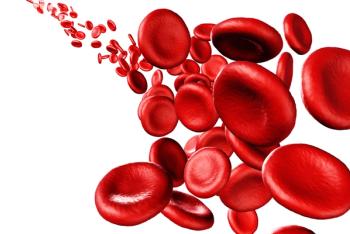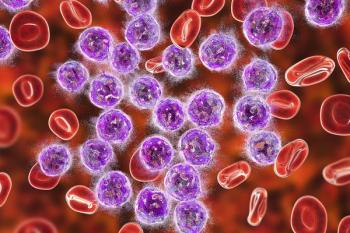
Vascular Events Remain a Problem for Ponatinib in CML
The efficacy of ponatinib in patients with newly diagnosed CML compared with imatinib remains to be established, as a randomized phase III trial was terminated early due to concerns regarding arterial occlusive events with ponatinib.
The efficacy of ponatinib in patients with newly diagnosed chronic myeloid leukemia (CML) compared with imatinib remains to be established, as a randomized phase III trial was terminated early due to concerns regarding arterial occlusive events with ponatinib. The termination came before sufficient patients reached 12 months of follow-up to show differences in efficacy.
Five tyrosine kinase inhibitors (TKIs) are approved to treat CML, though only four (ponatinib is the exception) have been tested in newly diagnosed patients. “Despite incremental advances in potency and antileukemic activity, all four inhibitors are susceptible to failure in untreated patients because of the development of mutations in the BCR-ABL1 kinase domain,” wrote researchers led by Jeffrey H. Lipton, MD, of Princess Margaret Cancer Centre in Toronto.
The new EPIC trial was an open-label, randomized, phase III study comparing ponatinib (155 patients) to imatinib (152) in newly diagnosed CML. Accrual began in August 2012 and the trial was terminated in October 2013 following concerns about vascular events observed with ponatinib in other trials (though not specifically from this study). The results of EPIC were
The termination of the trial occurred after a median follow-up period of only 5.1 months, and only 10 ponatinib and 13 imatinib patients were available for primary endpoint assessment, major molecular response (MMR) at 12 months. Among those, 8 of 10 ponatinib patients (80%) and 5 of 13 imatinib patients (38%) achieved an MMR (P = .074).
Ponatinib did have a significantly better rate of MMR at earlier intervals. At 9 months, 19 of 22 ponatinib patients (86%) and 9 of 27 imatinib patients (33%) achieved an MMR (P = .00031). At 6 months, these rates were 62% with ponatinib and 22% with imatinib (P < .0001).
A significantly higher proportion of patients achieved BCR-ABL1 transcript levels of less than 10% at 3 months with ponatinib (94%) than with imatinib (68%; P < .0001). Also, more ponatinib patients (74%) than imatinib patients (53%) achieved a complete cytogenetic response at any time point (P = .019).
With regard to safety, 11 ponatinib patients (7%) had arterial occlusive events, compared with only 3 imatinib patients (2%; P = .052). These were deemed serious in 10 ponatinib patients and in 1 imatinib patient. One ponatinib patient had a serious venous thromboembolic event.
“Premature termination of the trial and resultant small patient numbers restrict the interpretation of the results, which suggest benefit was observed with ponatinib compared with imatinib, although more arterial occlusive events were observed with ponatinib treatment,” the authors wrote, adding that the mechanism by which ponatinib contributes to vascular occlusive events is not yet well understood.
Newsletter
Stay up to date on recent advances in the multidisciplinary approach to cancer.
































































































